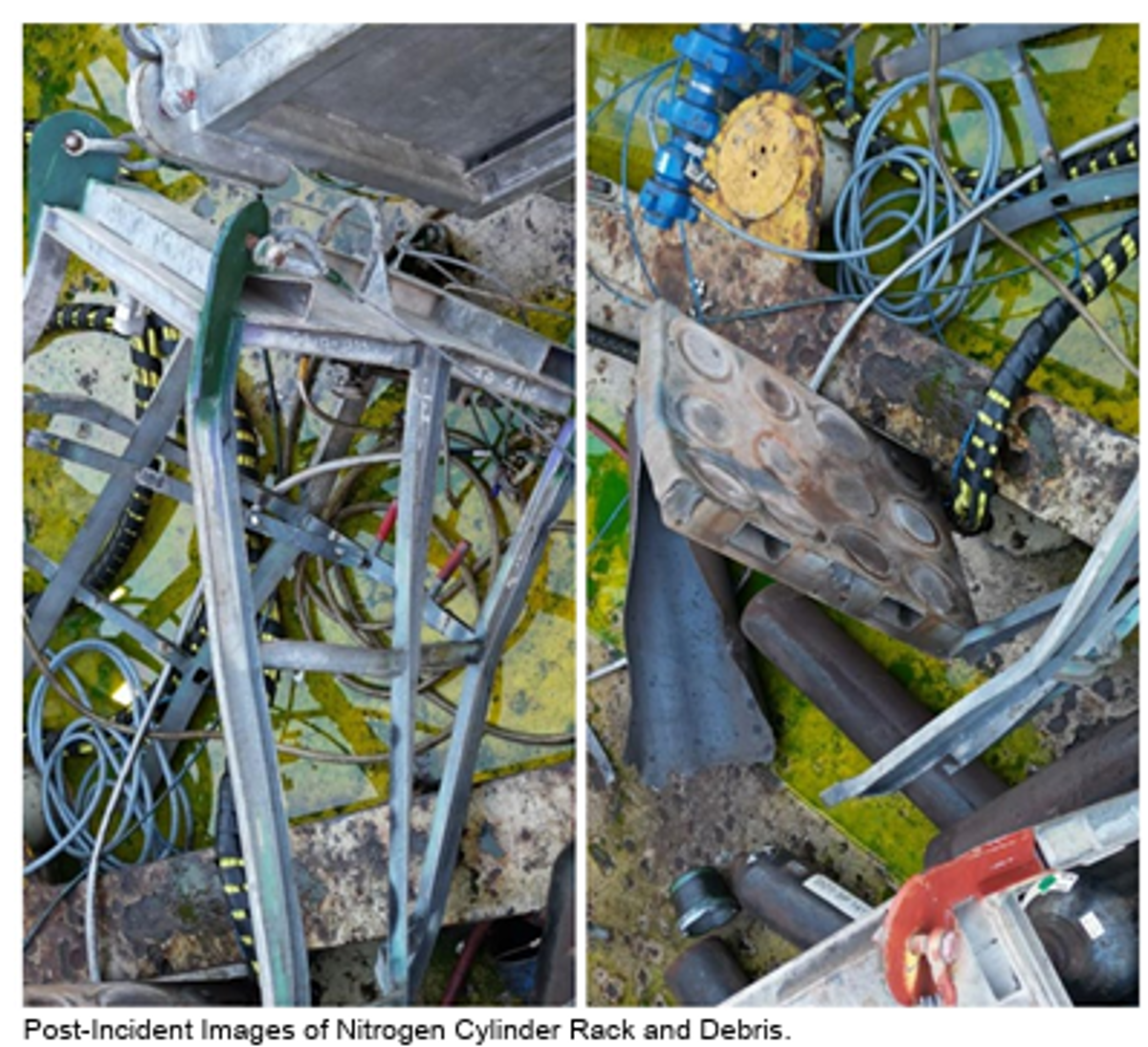BSEE: Nitrogen Cylinder Rupture Causing Worker Injuries and Equipment Damage
- Safety Flash
- Published on 29 April 2025
- Generated on 30 June 2025
- IMCA SF 08/25
- 3 minute read
Jump to:
The United States Bureau of Safety and Environmental Enforcement (BSEE) has published Safety Alert 494 relating to a Nitrogen Cylinder rupture which caused injuries and equipment damage.
What happened?
At the time of the incident, rig personnel had positioned a rack with 12 nitrogen cylinders to begin pre-charging the accumulator system cylinders with nitrogen. One of the nitrogen cylinders within the rack subsequently ruptured at its base, resulting in the dispersion of both the nitrogen cylinders and debris that was within the rack, as well as of the remaining cylinders situated in the immediate and port aft areas of the rig. Three rig personnel sustained minor injuries from shrapnel.
BSEE notes that “the failure of the nitrogen cylinder, which is attributed to corrosive wall loss exacerbated by environmental factors and structural conditions, highlights critical vulnerabilities in the storage and maintenance of nitrogen cylinders, particularly in marine environments. The presence of crevices at the base of the cylinders, combined with moisture accumulation, significantly accelerated the corrosion process, leading to the hazardous failure. Heavy deterioration of the galvanic coating on the storage rack further compounded the failure, indicating systemic neglect of maintenance protocols that could prevent such incidents.”

BSEE recommendations
· Ensure that all cylinders are properly labelled and marked with the appropriate markings required by local and international regulatory requirement;
· Verify that all cylinders are within their recertification period and have been properly recertified;
· Ensure that all cylinders are (only) filled to the appropriate pressure and the filling process is properly documented;
· Train all personnel handling and transporting high-pressure cylinders on the proper procedures and safety precautions;
· Train all personnel on the importance of monitoring environmental conditions and identifying the early signs of corrosion;
· Foster a culture of safety and diligence regarding the handling and maintenance of gas cylinders;
· Regularly review and update high-pressure cylinder safety procedures to ensure compliance with current regulatory requirements;
· Implement a robust inspection program and monitoring system to track the condition of high-pressure cylinders and storage racks regularly. Establish a reporting mechanism for any observed deterioration or safety concerns;
· Establish a routine maintenance schedule that includes cleaning, inspection, and protective coating application to prevent corrosion. This should also involve checking for and addressing any crevices or pooling of water around the bases of the cylinders.
Related Safety Flashes
-
IMCA SF 18/24
3 September 2024
-
IMCA SF 17/24
29 August 2024
-
IMCA SF 16/21
9 June 2021
-
IMCA Safety Flashes summarise key safety matters and incidents, allowing lessons to be more easily learnt for the benefit of the entire offshore industry.
The effectiveness of the IMCA Safety Flash system depends on the industry sharing information and so avoiding repeat incidents. Incidents are classified according to IOGP's Life Saving Rules.
All information is anonymised or sanitised, as appropriate, and warnings for graphic content included where possible.
IMCA makes every effort to ensure both the accuracy and reliability of the information shared, but is not be liable for any guidance and/or recommendation and/or statement herein contained.
The information contained in this document does not fulfil or replace any individual's or Member's legal, regulatory or other duties or obligations in respect of their operations. Individuals and Members remain solely responsible for the safe, lawful and proper conduct of their operations.
Share your safety incidents with IMCA online. Sign-up to receive Safety Flashes straight to your email.